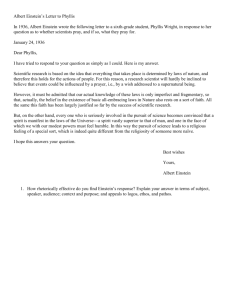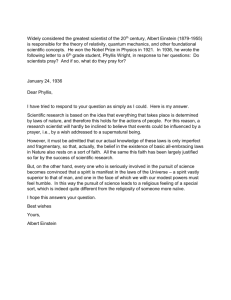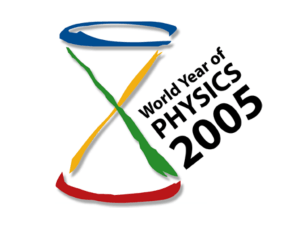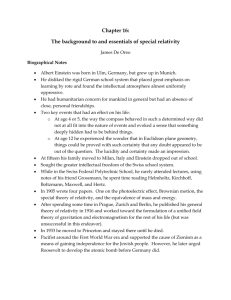The Einstein-Cartan- Evans Theory
advertisement
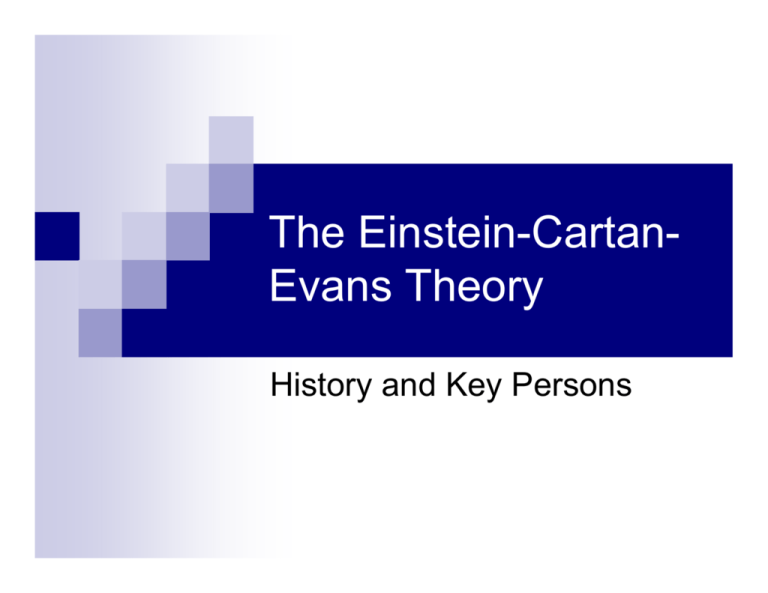
The Einstein-CartanEvans Theory History and Key Persons Outline E Einstein Cartan Evans Short History ECE-Theory C E 2 Élie-Joseph Cartan … … … … … … ... … was a French Mathematician (1869 - 1951) held posts at Montpellier, Lyon, and (1912–40) the Sorbonne, becoming one of the most original mathematicians of his time greatly developed the theory of Lie groups and contributed to the theory of subalgebras. founded the subject of analysis on differentiable manifolds, which is essential to modern fundamental physical theories. defined the connection and symmetric Riemann space Cartan was largely responsible for the modern abstract coordinate-free approach to geometry. although a profound theorist, Cartan was also able to explain difficult concepts to the ordinary student. from http://www.biography.com/search/article.do?id=9239799 3 Élie-Joseph Cartan born April 9, 1869, Dolomieu, France, died May 6, 1951, Paris in 1894 became a lecturer at the University of Montpellier, (Æ studied structure of continuous groups introduced by Sophus Lie) examined theories of equivalence and their relation to the theory of integral invariants, mechanics, and the general theory of relativity. in 1896 at the University of Lyon: working on linear associative algebra, developing general theorems based on the work of Benjamin Pierce at Harvard, exhibiting a subalgebra of Ferdinand Georg Frobenius. in 1912: professor at the Sorbonne, in 1913 discovering the spinors, complex vectors that are used to transform three-dimensional rotations into two-dim. representations. in 1931 member of the Academy of Sciences in France in 1947 a Fellow of the Royal Society of London. His works include: 1925: “The Geometry of Riemann Spaces” 1935: “The Theory of Continuous Groups and Generalized Spaces” from http://www.britannica.com/eb/article-9020535/Elie-Joseph-Cartan 4 Myron Wyn Evans born in 1950 (a Welsh chemist), more than 700 publications earned a B.Sc. and a Ph.D. in Chemistry / Univ. of Wales Aberystwyth. 1978: awarded the Harrison Memorial Prize by The Royal Society of Chemistry 1979: awarded the Meldola Medal Prize by The Royal Society of Chemistry and a Junior Research Fellow at Wolfson College, Oxford, Fellow of the University of Wales, SERC Advanced Fellow at the University of Wales Aberystwyth, researcher at IBM Kingston, New York, visiting scientist at Cornell Theory Center. he served briefly on the faculty of the Department of Physics at the University of North Carolina at Charlotte but resigned. spring of 2003: Einstein Cartan Evans (ECE) field theory then over a hundred scientific papers collected into a multi - volume monograph: M. W. Evans, "Generally Covariant Unified Field Theory" (Abramis, 2005 onwards), three volumes published to date (www.aias.us and www.atomicprecision.com). 2005: Appointed by Queen Elizabeth II to the British Civil List (science) from http://www.aias.us/Synopsis-scientific-career-Myron-Evans.html 5 Albert Einstein "Anyone who has never made a mistake has never tried anything new." - Albert Einstein Great spirits have always encountered violent opposition from mediocre minds. from http://www-history.mcs.st-andrews.ac.uk/history/Quotations/Einstein.html 6 Albert Einstein (1) … was a German--born theoretical physicist widely regarded as one of the greatest physicists of all time for his many contributions. … he formulated the special and general theories of relativity. … in addition, he made significant advancements to quantum theory and statistical mechanics. … best known for the Theory of Relativity (and specifically mass-energy equivalence, E=mc2), … he was awarded the 1921 Nobel Prize for Physics for his 1905 (his "wonderful year" or "miraculous year") explanation of the photoelectric effect and "for his services to Theoretical Physics". from http://en.wikipedia.org/wiki/Albert_Einstein 7 Albert Einstein (2) born in Ulm on March 14, 1879 as the first child of Hermann and Pauline Einstein,. in November 1881 Albert’s sister Maria was born. in Munich: elementary school and Luitpold grammar school. left school aged fifteen without any degree and followed his family to Milan. 1895 to 1896: school in Aarau (Switzerland, A-levels) in July 1900 finished his studies in Zurich (diploma of a subject teacher for mathematics / physics) Bern: work at the Patent Office. In his leisure time he worked in the area of theoretical physics. in 1905: publication of several of his important scientific works. dealing with the special theory of relativity the most famous formula in the world "E = m · c2“. 8 Albert Einstein (3) in 1903 marriage with his college mate Mileva Maric. in 1904 his first son, Hans Albert, was born in 1910 his second son Eduard followed in 1909 he became professor of theoretical physics at the University of Zurich, followed by a professorship in Prague and then again in Zurich in 1914 Einstein was called to Berlin to work there scientifically. in 1919 After separation from his wife Mileva he married his cousin Elsa Löwenthal. from 1909 to 1916 Albert Einstein worked on a generalisation of the special theory of relativity, the general theory of relativity. in 1919 this theory was proven right in an experiment (deflection of light by the sun’s gravitational field) Æ Einstein became famous over night. 9 Albert Einstein (4) in December 1932 he left Germany and never again entered German ground (Æ political situation in Nazi Germany) from 1933 Einstein and his family lived in Princeton, USA. working at the "Institute for Advanced Study" in December 1936 Einstein’s wife Elsa died. in 1939 World War II broke out. Æ fear that Germany was working on atomic bombs Æ letter to Franklin D. Roosevelt, the president of the United States of America, to tell him about the possibility of atomic weapons. in 1946 he proposed a world government in which he saw the only way to achieve continuous peace. the last years of his life in Princeton: working on a new theory, the unified field theory, which however was not successful. Albert Einstein died on April 18, 1955. 10 A Short History of ECE-Theory (1) ECE – Einstein – Cartan – Evans based on the theory of relativity suggestion of G. F. Fitzgerald of Trinity College Dublin followed by the mathematical development of H. A. Lorentz of Leiden theory and the vector electrodynamical equations of Oliver Heaviside In 1905: A. Einstein postulated the principles of special relativity 1906 to 1915: Einstein and Hilbert extended the theory of special relativity to the theory of general relativity for gravitation. In 1916 published: Einstein Hilbert field equation, (restricted to gravitational theory) in the early twenties, Cartan suggested to Einstein that the electromagnetic field be his torsion form within a scalar proportionality factor Æ but not brought to a final result 11 A Short History of ECE-Theory (2) in 1992 M. W. Evans inferred the spin field of electromagnetism from the inverse Faraday effect by a circularly polarized electromagentic field ("O(3) electrodynamics"). spring of 2003, Einstein Cartan Evans (ECE) field theory, which is based directly on Cartan (or differential) geometry. 2003: The equations of quantum mechanics and general relativity were unified the equations of the weak and strong fields were also unified with those of gravitation and electromagnetism, the Dirac equation derived from the ECE wave equation. through the use of the tetrad postulate of Cartan geometry, Æleading to the ECE Lemma and wave equation. thereafter: over a hundred scientific papers collected into a multi volume monograph: M. W. Evans, "Generally Covariant Unified Field Theory" (Abramis, 2005 onwards), three volumes published to date (www.aias.us). 12



